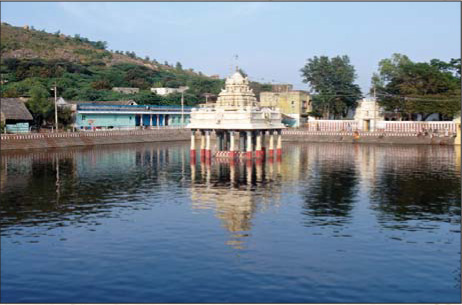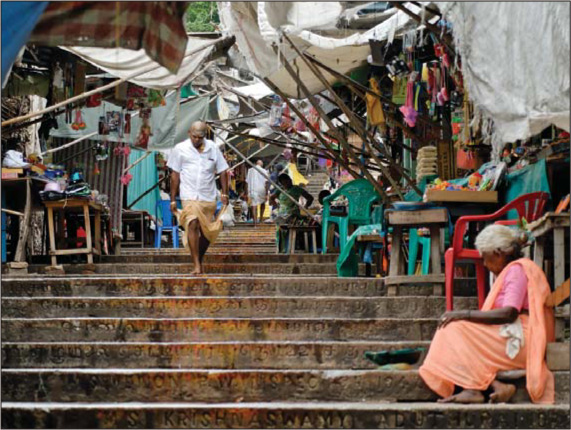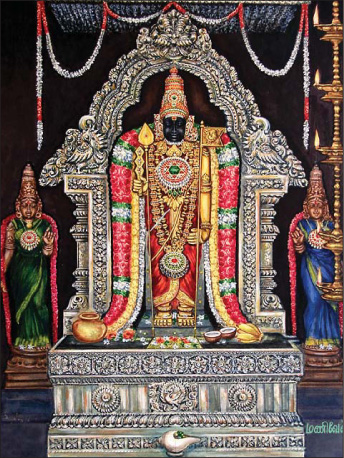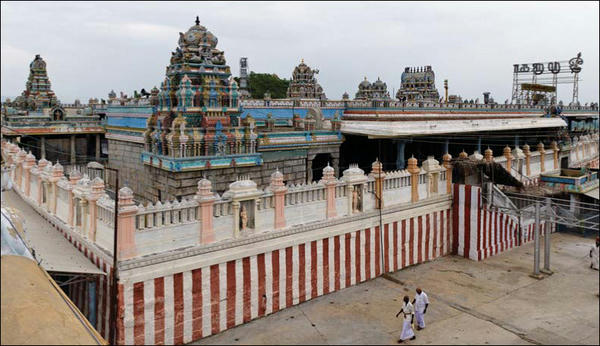

M. AMIRTHAM/DINODIA§
Placid pond: Murugan delights in red flowers, and Royal Poinciana trees like this one can be seen blooming around Tiruttani in the summertime
• • • • • • • • • • •§
 ITUATED 700 FEET ABOVE SEA LEVEL AMIDST A HILL range with a dramatic panoramic view is the Tiruttani Arulmigu Sri Subrahmanya Swami Tirukkoyil, Murugan’s fifth abode. From Swamimalai, the pilgrim usually goes to Trichy, the hub for traveling north to Chennai by bus, train or plane. Tiruttani is a small town located 84 km west of Chennai, 13 km north of Arakonam on the Chennai-Mumbai route. There are basic pilgrim accommodations in Tiruttani, but many choose to stay at Chennai or Kanchipuram (40 km to the south), making a day trip to Tiruttani.§
ITUATED 700 FEET ABOVE SEA LEVEL AMIDST A HILL range with a dramatic panoramic view is the Tiruttani Arulmigu Sri Subrahmanya Swami Tirukkoyil, Murugan’s fifth abode. From Swamimalai, the pilgrim usually goes to Trichy, the hub for traveling north to Chennai by bus, train or plane. Tiruttani is a small town located 84 km west of Chennai, 13 km north of Arakonam on the Chennai-Mumbai route. There are basic pilgrim accommodations in Tiruttani, but many choose to stay at Chennai or Kanchipuram (40 km to the south), making a day trip to Tiruttani.§
The hill at Tiruttani is known as Tanigaimalai, meaning “peaceful hill.” The name refers to the legend of Lord Murugan’s choosing this place for peace of mind and quiet relaxation after defeating Surapadman and marrying Devayanai. But there is much more significance to His presence here.§
The ode in Tirumurugarrupadai calls this place Kunrutoradal and describes Murugan as Ceyon, the “Red God” who loves to sport in the hills. Ratna Navaratnam writes of the ancient tribals and their worship here: “The worship of Murugan takes the form of a dance known as veriyadal in the hilly and forest regions. These highlanders celebrated God Murugan as their guardian Deity and believed that the welfare of their tribe was His concern.” The hill folk, in long, night-draped dances fueled by honey wine, sought to bring the whole tribe into Murugan’s aura, much as the Vedic priests of the North imbibed soma to plunge into a vision-quest of Skanda. Navaratnam explains that they used dance and music to propitiate Murugan for practical assistance, such as to heal disease or alleviate famine or drought. These tribal dance forms are incorporated into today’s kavadi (milk-pot-carrying penance to Murugan) processions celebrated worldwide.§

HINDUISM TODAY§
Tiruttani’s tank, called Saravana Poigai, at the bottom of the hill
• • • • • • • • • • •§
This abode of Murugan is also the birthplace of India’s first vice-president and second president, Dr. S. Radhakrishnan. Yet, it holds even more legendary significance. According to Murugan bhaktar Patrick Harrigan, a host of Gods, saints and sages are known to have worshiped Lord Subrahmanyam here, including Rama, Arjuna, Vishnu, Sage Agastiyar, Saint Arunagirinathar, Saint Ramalinga Swamigal and Sri Muttuswami Deekshitar.§
Arriving at the bottom of the hill, we encounter the enchanting Saravana Poigai. Our priest and guide, Sivasri K.V. Ravi Gurukkal, tells us, “This tank is renowned for its sacred water which is known to have healing effects for both bodily and mental illnesses.” After bathing our feet, we turn and ascend the hill via 365 steps, representing the days of the year.§
At the top, it is cool and quiet, and one immediately understands why Murugan chose this place for solace. Here it is easy to view the world below from a mountaintop consciousness. A new perspective is gained. In Tiruttani’s setting, the vishuddha chakra is amplified—the unadulterated energy of cosmic love. When there is an inexpressible love and kinship with mankind and all life forms, our consciousness resides in this chakra at the throat. When deeply immersed in this state, there is no consciousness of a physical body, of being a person with emotions or intellect. One just is the light flowing through all form. Ineffable bliss permeates the subtle nerve system as the truth of the oneness of the universe is fully and powerfully realized.§
As He strides on the peacock with the ram behind, the flawless banner of the cock is raised aloft; adorned with armlets, waist tucked with trailing robes, His stature rises as He roves with bands of singers, their voices sweet as notes of well-tuned lutes.§
TIRUMURUGARRUPADAI, LINES 210-214§

Worship’s way: Tiny shops and the occasional beggar line the steps going up the hill
• • • • • • • • • • •§

M. AMIRTHAM/DINODIA§
Head priest Sivasri K.V. Ravi Gurukkal performs arati for the utsava murti
• • • • • • • • • • •§

A. MANIVEL§
A bird’s eye view of the temple
• • • • • • • • • • •§

M. AMIRTHAM/DINODIA§
Artist’s rendition of the main shrine
• • • • • • • • • • •§
Ascending the final steps to the east entrance, we again encounter Indra’s white elephant where one would expect to see Lord Murugan’s peacock mount. In an even more unusual twist, the elephant faces east, away from the shrine. T.G.S. Balaram Iyer, in his book South Temples, offers, “Some consider that the Lord is ever ready to start on His carrier and rush to the aid of devotees”—meaning the elephant would not even have to turn around to begin a campaign.§
Ravi Gurukkal takes us aside to tell more about the temple and its priesthood. There are 27 Adisaiva families serving the temple. He proudly explained, “We follow a strict discipline here. When it is a priest’s turn to do the puja, he must fast, bathe in a designated place inside the temple, then meditate in front of the shrine. Only then can he go inside the sanctum and do the puja.” This sadhana clearly has an effect, as we found them all so humble and content, quiet and composed.§
As the puja begins, we are once again captured by Lord Subrahmanyam. Unlike most temple protocols, all offerings except the abhishekam itself are made from outside the shrine, right in front of us. There is something exceptionally sweet about the ritual here: the priests are unhurried and unusually present. Performing the sacred rites is, for these priests, a delightful dance of divine communion, as it was for the tribals of ancient times.§